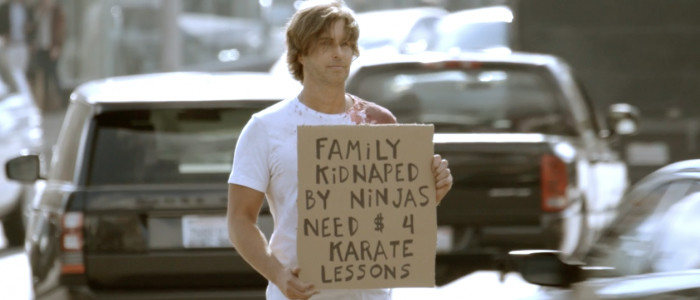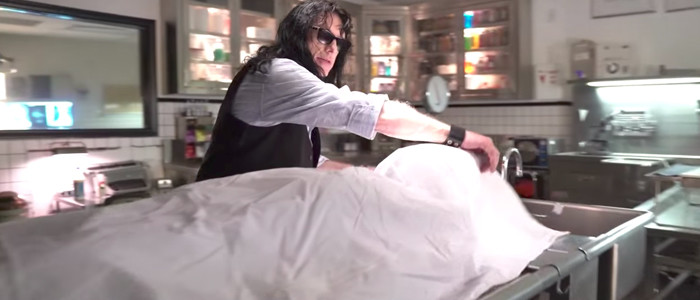'Best F(r)iends' Reunites 'The Room' Stars Tommy Wiseau And Greg Sestero For A Bizarre Crime Tale [Beyond Fest]
With Tommy Wiseau and Greg Sestero, the stars of Wiseau's legendarily awful 2oo3 drama The Room, co-starring in a new movie together, comparisons to that original disasterpiece are impossible to avoid. Best F(r)iends, a new buddy crime movie directed by Justin MacGregor and written by Sestero, embraces the inevitable juxtaposition by acknowledging and paying homage to The Room throughout its entire run time: it's not a sequel, but it's clearly a spiritual successor and often feels like it could be set in the same cinematic Wiseau-niverse.
To watch Best F(r)iends is to step through a portal into a bizarre, topsy-turvy world in which Wiseau is once again a lead character in a feature film, still very much in possession of all the unique eccentricities his fans have found so strangely irresistible. 14 years later, this is the same old Tommy, and those who have worn out their DVD copies of The Room are going to go nuts for it.
Sestero plays a bloodied, bearded homeless man named Jon who wanders the streets of Los Angeles with a series of signs that say things like, "Family Kidnaped [sic] by Ninjas. Need Money 4 Karate Lessons." Jon quickly meets an oddball mortician named Harvey (Wiseau), who spends the whole movie wearing huge platform heels and baggy parachute pants. Their very first line of dialogue speaks volumes: when Harvey pulls his hearse into his morgue lot and sees Jon watching him from outside the open gate, Harvey inquires in that specific way only Wiseau can: "Are you going to stand out there like the Statue of Liberty?"
Harvey feels bad for Jon, so he cleans him up and gives him a job at the morgue – but this isn't just any morgue. Harvey makes latex masks of famous actors – from Marlon Brando to Tupac Shakur – and puts them on the faces of deformed corpses so they can look beautiful on their trip to paradise. (And that's maybe the fourth-weirdest thing about his business.) Harvey also collects the gold dental pieces from the bodies he brings in, and that provides the foundation on which the whole rest of the plot is built. Jon decides to steal some gold and trade it for cash, and the story spins out of control from there as the pair get involved with shady dealers – including one played by Paul Scheer (!) – and cryptic details about Harvey's backstory are slowly revealed. To list the film's quirks would not only take all day, but would rob you of any magic it offers, because if this movie has any charms at all, it's in the tiny moments and interactions between characters.
 Best F(r)iends wouldn't exist without The Room, and while the filmmakers insisted the two were separate stories in a post-film Q&A, this movie doesn't have the balls to fully be its own thing. It's peppered with references and callbacks, like Harvey saying, "Oh, hi Jon," and Harvey and Jon having a heart-to-heart conversation while tossing a basketball back and forth. These moments basically serve the same function as the Stan Lee cameos in Marvel movies: to wink at the audience and let them feel like they're in on the joke. There are also a few times when Wiseau is let completely off the leash in a forced attempt to recapture the meme-worthy moments from The Room. But all of these references are so blatant that they feel like pandering instead of a natural extension of this particular story.
Best F(r)iends wouldn't exist without The Room, and while the filmmakers insisted the two were separate stories in a post-film Q&A, this movie doesn't have the balls to fully be its own thing. It's peppered with references and callbacks, like Harvey saying, "Oh, hi Jon," and Harvey and Jon having a heart-to-heart conversation while tossing a basketball back and forth. These moments basically serve the same function as the Stan Lee cameos in Marvel movies: to wink at the audience and let them feel like they're in on the joke. There are also a few times when Wiseau is let completely off the leash in a forced attempt to recapture the meme-worthy moments from The Room. But all of these references are so blatant that they feel like pandering instead of a natural extension of this particular story.
I was far more interested in the commentary that was baked into Sestero's script. He was inspired to write it after taking a post-Room road trip with Wiseau in which Wiseau apparently thought he was being lured away to be killed, but there are plenty of instances here which feel like they're directly addressing the oddity of their real-life relationship and their unexpected status as cult icons. Jon refers to Harvey as "an incredible artist" when he sees the masks Harvey makes, and Harvey explains, "My goal is to make people happy." Harvey buys an expensive classic car at a discount because its side detailing doesn't quite align, which in film language means equates Harvey/Tommy Wiseau with this one-of-a-kind car. It's not the most subtle messaging in the world, but at least it's trying. At the heart of the crime story, it's a tale of two lonely outcasts trying to find a friend in the world and becoming united by their offbeat job that no one else can really understand – at one point, Jon tells Harvey, "I think we needed each other to find out who we really are." The parallels between the characters and what's happened to Greg and Tommy since The Room became a cult hit are, like Tommy's accent, impossible to ignore.
Speaking of The Room: while that film was comically limited in scope, MacGregor expands the scope of Best F(r)iends to be a sprawling L.A. crime saga that takes the audience all across the city. It still has a distinctly indie vibe (read: it looks cheap), but there's a visual ambition here that The Room didn't strive for, especially in a scene involving a trip to Las Vegas that borders on Lynchian as the characters fall apart under the casino's flashing lights. Still, consciously or not, Best F(r)iends suffers from a myriad of technical problems: dialogue scenes happen on busy streets with overwhelming car noise in the background, many of the conversations don't make any narrative sense, Wiseau's ad-libbing tends to contradict things he's previously said, etc. Some of that may be due to the fact that we watched a work-in-progress version with a temp score, but regardless, I found a lot of this film to be insufferable. But those who unabashedly love The Room will almost surely enjoy this movie's charms.
Warning: spoilers ahead. Without giving away specific plot details (who lives, who dies, whether the two lovers end up together, etc.), I'm going to talk about the movie's ending and reveal something you're almost certainly going to know about by the time this comes to theaters next year.
Jon strikes up a relationship with a bartender (Kristen StephensonPino) but keeps his dealings secret from her. When she eventually figures out what he's really up to and learns that Harvey is controlling the money they've made selling gold, she concocts a plan for Jon to take his share of the cash so the two of them can move to Colorado together. The thing is, this scheme is devised nearly an hour and a half into a movie that's supposed to be an hour and thirty-nine minutes long. What gives?
The plan is put in place, and after a climactic cliffside confrontation between Harvey and Jon, the real title of the film hits the screen: Best F(r)iends Volume One. The Beyond Fest audience lost their shit when that happened, and for the next couple of minutes, the imagery becomes far more surreal than anything we've seen thus far as a teaser for the second entry plays out: a lone cowboy stands on a ridge, a man staggers toward him engulfed in flames, we see Harvey wearing a mask of Jon's face...and it all ends with "2018." MacGregor explained in a Q&A that they made two movies and just didn't realize it at the time. He said they're nearly finished with Volume Two already, and when I briefly spoke with Sestero afterward, he confirmed to me that the plan is to release Volume One and Volume Two as two separate films in 2018.
"What did you think? Something different, right?" Wiseau asked the audience right after the credits rolled and the lights came up. While the story is definitely its own thing, Best F(r)iends shares a considerable amount of DNA with Wiseau's most infamous work – "Friendship before money" is one of the main themes, exploring ideas of broken loyalty just like The Room – and it'll be interesting to see if audiences embrace this in the same way they championed a cult phenomenon no one could have ever predicted.
How does one go about rating a movie like this on a 0-10 scale? Do you judge the same criteria as you would for any other film, or attempt to factor people's "so bad it's good" enjoyment into the final number? I'll go with the former, but it's not going to matter in the end. I know we often talk about big blockbusters as being critic-proof, but it's tough to think of something more critic-proof than Best F(r)iends. The rating is almost totally meaningless: those who are curious about this aren't going to let any rating stop them from seeking it out, and frankly, that's the way it should be. Though I personally didn't care much for it, I can easily imagine some of you going wild for this unusual reunion. For comparison's sake, I'd give The Room a 1 out of 10, so make of that what you will.
/Film Rating: 3.5 out of 10

